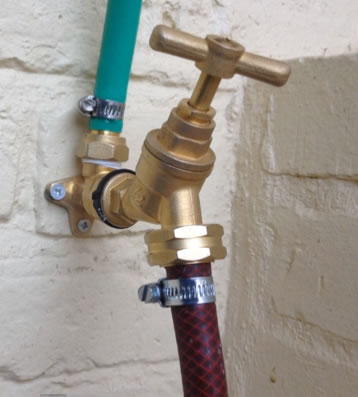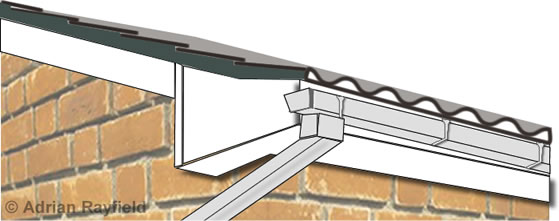Painting, decorating and home improvement tips blog
Autumn and winter jobs for around the home and garden
Posted by Adrian
October 31st, 2018

Autumn and winter jobs for around the home and garden
Winter is fast approaching and before the really cold and wet weather gets here now is the ideal time to do maintenance jobs around the home and garden in preparation for winter. So if you have a spare half day or a weekend and the weather is a lovely autumnal day why not get out in the winter sun and do those jobs ready for the winter months.
Leaves
Leaves look nice when they are golden brown and red whilst they are still on the trees but as they fall off they can be a real pain. They can make driveways and paths slippery under foot, block gutter and downpipes and generally make the garden look untidy.
So a good sweep up can make the world of difference and as an added bonus you can bag them up and compost them ready to be spread of the vegetable patch the following year.
Gutters and downpipes
As mentioned above, leaves can build up and block gutters and downpipes creating drainage problems and potentially damp issues in the property. If you have a ladder or access to one or maybe a friendly neighbour with a ladder you could borrow, you can clean out the leaves from the guttering and downpipes along with other debris that may of accumulated over the past year such as sand and grit from the roof tiles and grass that may of started growing, even bird nesting materials.
Simply remove the debris and run some water along the gutter and downpipe from a hose or watering can to ensure the gutters are in good condition, flow freely and don’t leak.
Broken glass and windows
If you have any broken or cracked window panes it is a good idea to get them fixed or replaced. If you have single glazing this is especially important to help reduce heat loss and draughts from getting in.
You will also stop any water being able to get in and causing more damage.
Draught excluder
If you have draughts around doors and windows, or even letter boxes you can quickly and relatively cheaply reduce or completely eliminate them simply by buying and fitting draught excluders.
Draught excluders and readily available from DIY merchants and stores and are easy to fit, many door and window draught excluders simply are self adhesive, some require fitting with screws, such as in the case of a letter box draught excluder.
Roof tiles
Slipped, missing or cracked roof tiles could potentially cost you a lot of money in damage. If water gets into a loft space and you are unaware of it not only could the contents of your loft be damaged but eventually the room ceilings and walls will get damp, this could be costly to put right.
So to prevent this take a walk outside and look up at your roof, can you see and ridge tiles missing, or any broken or cracked tiles, if there are either replace them yourself, or better still, call a roofer to do it for you.
If you have flat roofs do you get a pool of water when it rains, this could create a problem or even be a sign of a problem, if you have a pool of water after it rains on your flat roof it could mean the boards under the felt are rotten and sunk thus leaving a dip in the felt for the rain to gather, again it is worth investigating yourself or calling a roofer.
Painting
Ok the winter isn’t the best time for painting outside but you could to a temporary job by making sure wood is protected with paint, a simple undercoat and topcoat on the bare areas could help protect the wood over the winter and you can go back and do a proper job in the spring of the following year.
Boiler and heating
We all rely on our heating this time of year, so it is worth checking everything is working OK before the really cold weather comes, if you have radiators that are colder at the top than the bottom you may need to bleed your radiators, if you are unsure of this ask a plumber.
You should always call an registered gas fitter if you need work done on your boiler or gas fire.
If you have an open fire, when was the last time you had the chimney swept, does it need doing before you have an open fire?

Outside tap
If you have a outside or garden tap you should make sure the pipes are lagged to avoid the pipes from freezing, also if possible turn off the isolator valve that feeds the outside tap and drain off the water by opening the tap, so there is no chance of the water freezing. You could also buy and fit a garden tap jacket that goes over the tap to keep it from freezing.
Flooding and snow be prepared
If heavy snow is forecast make sure you know where the snow shovel is, if you have one. You can also buy rock salt for your paths and driveways. Keep heating on but at a lower level to help keep the house warm. Be aware of sliding snow of thawing roofs. If you have a conservatory you should ideally have a snow guard fitted to the fascia to prevent snow sliding on the the conservatory roof and damaging it.
If major flooding is warned, take all valuables upstairs to keep them dry and safe. Put sandbags at the bottom of doors to try and reduce the amount of water getting in. Take a look at the Met office guidance for flooding.
Tags: Autumn, DIY, Downpipe, Draught Excluder, Garden Tap, Gutter, Leaves, Maintenance, Outside Tap, Painting, Roof, Roof tiles, winter
Posted in Home Improvements | No Comments »
Painting pipes and Pipework
Posted by Adrian
January 31st, 2017

Painting Pipes and pipework
From time to time we have to paint pipes or pipework, this can be inside or outside a property. It could be plastic PVCu drainage pipes from kitchens or bathrooms, or maybe copper water pipes for heating etc.
What ever the situation un-painted pipes can look unsightly, pipes look better painted. They maybe in a different colour, sometimes a different finish such as gloss or satinwood.
To get a good professional finish you don’t want to get paint from the pipes onto the surrounding area, such as walls. A good trick is to put cardboard of a sheet of paper or old wallpaper behind the pipes to protect the area behind getting splashed or the brush touching the wall as you try to get the back part of the pipes, once done you will have beautifully painted pipes and no paint on the walls behind.
This tip works for all types of pipework, interior and exterior.
How to paint pipes and paintwork
To paint new copper pipes you need to ensure they are free from any plumbing flux and grease, so a wipe over with soapy water, methylated spirits or white spirit should remove this. With the pipes clean you can prime the pipes and then topcoat. I prefer satinwood but you can use gloss or emulsion. Oil based paints can yellow on hot water or heating pipes due to the heat.
To paint previously painted copper pipes, give them a quick wipe over to remove any dust etc, gently rub down to give a key, prime / undercoat and them topcoat with your preferred paint.
To paint plastic PVCu pipes, such as soil pipes, drainage pipes etc, ensure they are free from dirt and debris, including any plumbing grease etc. Give them a rub down with a fine grit sandpaper to give it a key, then prime, and paint with topcoat of choice.
Tags: Bathroom, Copper, Downpipe, heating, Kitchen, Painting, Pipes, Pipework, Plumbing, UPVC
Posted in Decorating Tips | No Comments »
How to fit new guttering
Posted by Adrian
August 25th, 2012

How to put up new guttering
With the end of the summer quickly approaching now is a good time to start thinking about jobs that need doing before the winter sets in. One job that may need doing is guttering, you may need to fix a leaking joint or replace a length of damaged downpipe. Whatever the job now is a good time to do it.
Choosing your guttering
If you are having new guttering you need to decide on which type be it round or square and the colour you prefer, black, brown or white. Then measure up allowing for any cutting that maybe required. Make sure you get enough brackets for the gutter and downpipes. It is advised to have a bracket every metre, this will give the gutter enough support when you get heavy snow sitting in it.
Buying the guttering
Once you have decided on your gutter and measured up it is now time to buy the guttering, ensure you get any outlets either running outlet or stopend outlet, stopends, any angled gutter, a shoe/boot for the end of the downpipe, downpipe and clips, and any union brackets.
Fixing the guttering
You may find it easier with two people to do this job, so now the time to call on a mate to help, but it can be done by just one person for those people with no mates!
Decide on where the outlet is going to be, you may not have a choice as the downpipe may go into a drain or you may want it to go into a water butt. The important thing to remember is the outlet has to be the lowest point for the water to run out of it. One additional tool you will need for this job is some string, this could be a chalk line or string you found in your wife’s craft draw! it doesn’t matter as long as it is long enough to span the length of where your fixing the guttering, which may be the entire width of the house, so a good 5 or 6 metres will be needed.
Now you know where the outlet is going, you can start to fix the guttering, take a bracket and place it against the fascia board and close to the roof tiles , mark the holes, drill and screw the first bracket to the fascia. Now go to the other end of the fascia, if the outlet is going to be at one end, come in about a metre from the end of the fascia and fix another bracket about an inch and a half down from the roof tiles. Now take your string and tie it between the two brackets pulling it tight to give it tension, this will give you a nice gentle fall toward the outlet. Now simply take a bracket measure about a metre from the first one, slide the bracket up to the string line, drill and screw, continue doing this until you get all the way along, you may have to decrease the gap to get brackets around a metre apart, don’t increase by much as the weight of the next snow could pull your gutter down.
If you have your outlet in the middle of the fascia, the same principle applies but work from one side then the other toward the middle, or wherever the outlet is.
Once all the brackets are up you can work out where the stopend outlet needs to be fixed, remember this still needs to continue to have a fall on it from the the last bracket you fitted.
Putting it all together
Next you need to measure and cut the gutter to fit between any union brackets or stopends, once all clipped into place you need to fit the downpipe, cut and fit the the downpipe and angles together to get the downpipe to where you want it to go, simply secure the downpipe to the wall with the downpipe brackets. Ideally your rain water would go into a water butt, this can easily be done by using a water butt connector, this allows the water butt to be filled from the downpipe and when it’s full will continue down the downpipe to a drain, so not overflowing.
Tags: Downpipe, Gutter, Guttering, Running Outlet, Stopend, Stopend Outlet, Union Bracket
Posted in Decorating Tips | No Comments »
